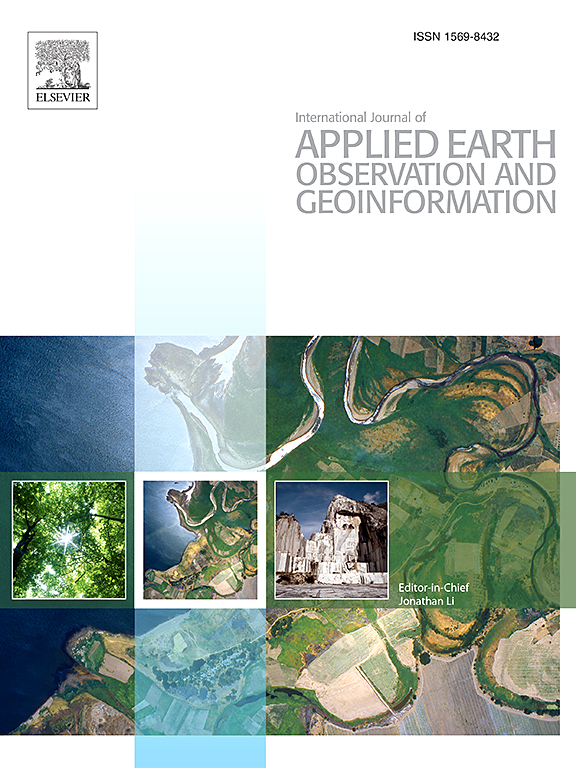自然和改良生态系统中木本植被和冠层覆盖的多传感器建模
IF 8.6
Q1 REMOTE SENSING
International journal of applied earth observation and geoinformation : ITC journal
Pub Date : 2025-05-30
DOI:10.1016/j.jag.2025.104635
引用次数: 0
摘要
遥感是监测植被范围和生物物理属性的重要工具。多传感器方法可以降低开发高质量数据集的成本并提高预测性能,因此越来越普遍。尽管有这种趋势,但除了统计性能之外,这些数据融合技术的优势很少被报道。我们使用机载激光雷达衍生的度量来开发冠层覆盖(CC, %)和木本植被(WV,存在/缺失)的模型,使用来自Sentinel-1 (S1 c波段,5.5 cm波长,合成孔径雷达)和Sentinel-2 (S2,多光谱光学)卫星星座的旱季图像,涵盖澳大利亚东南部塔斯马尼亚州的自然和改良农业生态系统。18876个样本位置的验证统计表明,当使用S1和S2变量进行预测时,CC (R2 = 0.83, RMSE = 0.13)和WV (OA = 0.94, Kappa = 0.87)的性能都很好。SAR变量提供的统计性能的微小改进(通常为CC和WV的1 - 2%)低估了S1在区分木本植被和量化非木本生态系统(如高山植被、石南荒原、湿地、沿海灌丛)的冠层覆盖方面的好处,表明了多传感器预测的互补优势。自然资本核算和“自然积极倡议”(Nature Positive Initiative)等框架的出现和发展,意味着对高质量、具有成本效益的空间数据集的需求将继续存在。我们的研究证明了非商业的、可公开获取的遥感图像在改善精细分析方面的潜力,否则大规模应用可能成本过高。本文章由计算机程序翻译,如有差异,请以英文原文为准。
Multi-sensor modelling of woody vegetation and canopy cover across natural and modified ecosystems
Remote sensing is an essential tool for monitoring the extent and biophysical attributes of vegetation. Multi-sensor approaches, that can reduce the costs of developing high-quality datasets and improve predictive performance, are increasingly common. Despite this trend, the advantages of these data-fusion techniques are rarely reported beyond statistical performance. We use airborne lidar-derived metrics to develop models of canopy cover (CC, %) and woody vegetation (WV, presence/absence) using dry-season imagery from the Sentinel-1 (S1 C-band, 5.5 cm wavelength, Synthetic Aperture Radar) and Sentinel-2 (S2, multispectral optical) satellite constellations across natural and modified agricultural ecosystems in Tasmania, southeast Australia. Validation statistics at 18,876 sample locations demonstrated strong performance for both CC (R2 = 0.83, RMSE = 0.13) and WV (OA = 0.94, Kappa = 0.87) when using both S1 and S2 variables for prediction. The small improvement in statistical performance provided by SAR variables (typically 1–2 % for CC and WV) understated the benefits of S1 for discriminating woody vegetation and quantifying canopy cover in non-woody ecosystems (e.g., alpine vegetation, heathlands, wetlands, coastal scrub), demonstrating the complementary benefits of multi-sensor prediction. The emergence and growth of natural capital accounting and frameworks such as the Nature Positive Initiative, mean that high-quality, cost-effective spatial datasets will continue to be in demand. Our study demonstrates the potential of non-commercial, publicly accessible remote sensing imagery to improve fine-scale analyses that may otherwise be cost-prohibitive to apply at scale.
求助全文
通过发布文献求助,成功后即可免费获取论文全文。
去求助
来源期刊

International journal of applied earth observation and geoinformation : ITC journal
Global and Planetary Change, Management, Monitoring, Policy and Law, Earth-Surface Processes, Computers in Earth Sciences
CiteScore
12.00
自引率
0.00%
发文量
0
审稿时长
77 days
期刊介绍:
The International Journal of Applied Earth Observation and Geoinformation publishes original papers that utilize earth observation data for natural resource and environmental inventory and management. These data primarily originate from remote sensing platforms, including satellites and aircraft, supplemented by surface and subsurface measurements. Addressing natural resources such as forests, agricultural land, soils, and water, as well as environmental concerns like biodiversity, land degradation, and hazards, the journal explores conceptual and data-driven approaches. It covers geoinformation themes like capturing, databasing, visualization, interpretation, data quality, and spatial uncertainty.
 求助内容:
求助内容: 应助结果提醒方式:
应助结果提醒方式:


